Honor Award
The Garden Diary of Martha Turnbull, Mistress of Rosedown Plantation
Suzanne Turner, FASLA, Baton Rouge, LA
Client: Friends of Oakley
Publisher: Louisiana State University Press
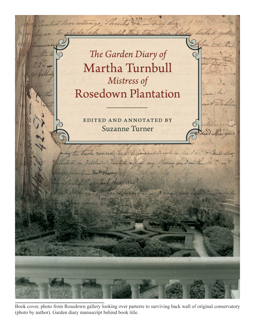 Close Me!
Close Me!Book cover, photo from Rosedown gallery looking over parterre to surviving back wall of original conservatory (photo by author). Garden diary manuscript behind book title.
Download Hi-Res ImageImage: Suzanne Turner
Image 1 of 15
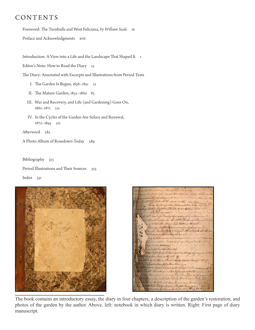 Close Me!
Close Me!The book contains an introductory essay, the diary in four chapters, a description of the garden's restoration, and photos of the garden by the author. Below, left: notebook in which diary is written. Right: First page of diary manuscript.
Download Hi-Res ImageImage: Suzanne Turner
Image 2 of 15
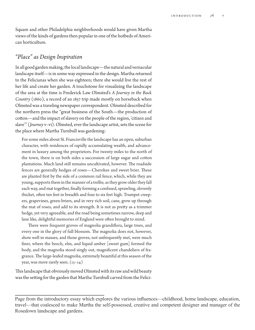 Close Me!
Close Me!Page from the introductory essay which explores the various influences—childhood, home landscape, education, travel—that coalesced to make Martha the self-possessed, creative and competent designer and manager of the Rosedown landscape and gardens.
Download Hi-Res ImageImage: Suzanne Turner
Image 3 of 15
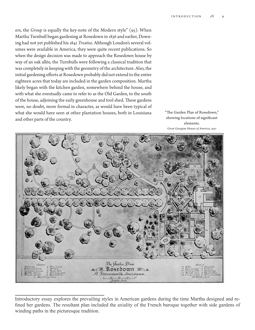 Close Me!
Close Me!Introductory essay explores the prevailing styles in American gardens during the time Martha designed and refined her gardens. The resultant plan included the axiality of the French baroque together with side gardens of winding paths in the picturesque tradition.
Download Hi-Res ImageImage: Suzanne Turner
Image 4 of 15
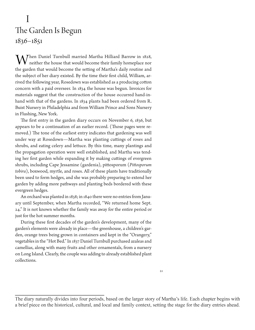 Close Me!
Close Me!The diary naturally divides into four periods, based on the larger story of Martha's life. Each chapter begins with a brief piece on the historical, cultural, and local and family context, setting the stage for the diary entries ahead.
Download Hi-Res ImageImage: Suzanne Turner
Image 5 of 15
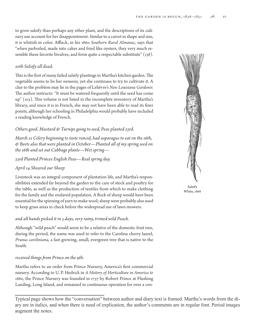 Close Me!
Close Me!Typical page shows how the “conversation” between author and diary text is framed. Martha's words from the diary are in italics, and when there is need of explication, the author's comments are in regular font. Period images augment the notes.
Download Hi-Res ImageImage: Suzanne Turner
Image 6 of 15
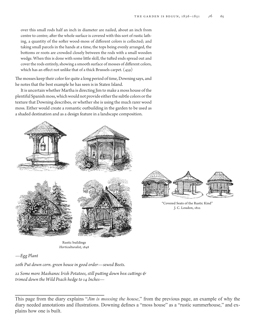 Close Me!
Close Me!This page from the diary explains “Jim is mossing the house,” from the previous page, an example of why the diary needed annotations and illustrations. Downing defines a “moss house” as a “rustic summerhouse,” and explains how one is built.
Download Hi-Res ImageImage: Suzanne Turner
Image 7 of 15
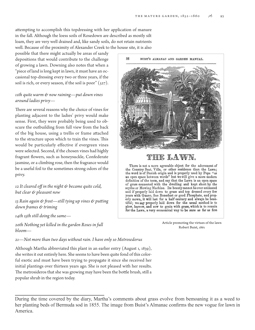 Close Me!
Close Me!During the time covered by the diary, Martha's comments about grass evolve from bemoaning it as a weed to her planting beds of Bermuda sod in 1855. The image from Buist's Almanac confirms the new vogue for lawn in America.
Download Hi-Res ImageImage: Suzanne Turner
Image 8 of 15
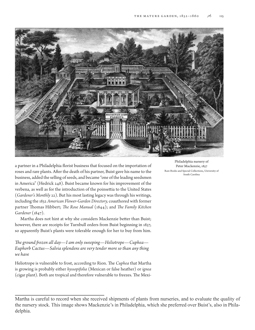 Close Me!
Close Me!Martha is careful to record when she received shipments of plants from nurseries, and to evaluate the quality of the nursery stock. This image shows Mackenzie's in Philadelphia, which she preferred over Buist's, also in Philadelphia.
Download Hi-Res ImageImage: Suzanne Turner
Image 9 of 15
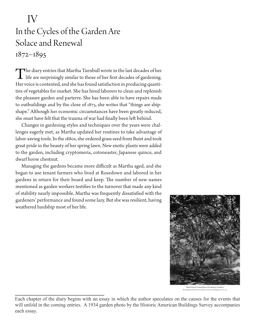 Close Me!
Close Me!Each chapter of the diary begins with an essay in which the author speculates on the causes for the events that will unfold in the coming entries. A 1934 garden photo by the Historic American Buildings Survey accompanies each essay.
Download Hi-Res ImageImage: Suzanne Turner
Image 10 of 15
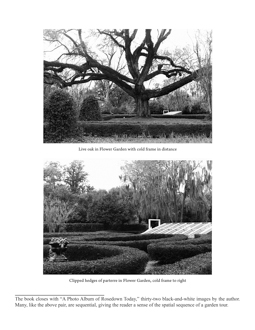 Close Me!
Close Me!The book closes with “A Photo Album of Rosedown Today,” thirty-two black-and-white images by the author. Many, like the above pair, are sequential, giving the reader a sense of the spatial sequence of a garden tour.
Download Hi-Res ImageImage: Suzanne Turner
Image 11 of 15
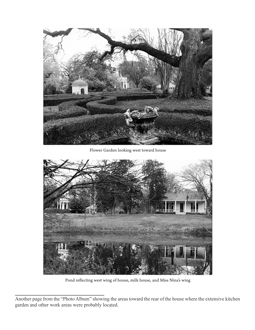 Close Me!
Close Me!Another page from the “Photo Album” showing the areas toward the rear of the house where the extensive kitchen garden and other work areas were probably located.
Download Hi-Res ImageImage: Suzanne Turner
Image 12 of 15
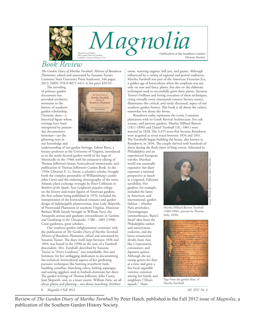 Close Me!
Close Me!Review of The Garden Diary of Martha Turnbull, by Peter Hatch, published in the Fall 2012 issue of Magnolia, a publication of the Southern Garden History Society.
Download Hi-Res ImageImage: Suzanne Turner
Image 13 of 15
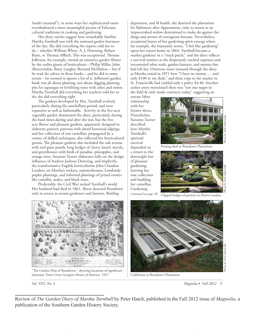 Close Me!
Close Me!Review of The Garden Diary of Martha Turnbull, by Peter Hatch, published in the Fall 2012 issue of Magnolia, a publication of the Southern Garden History Society.
Download Hi-Res ImageImage: Suzanne Turner
Image 14 of 15
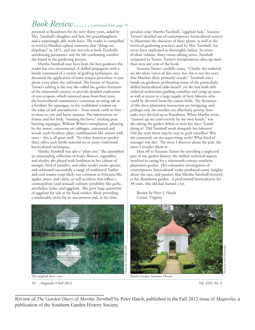 Close Me!
Close Me!Review of The Garden Diary of Martha Turnbull, by Peter Hatch, published in the Fall 2012 issue of Magnolia, a publication of the Southern Garden History Society.
Download Hi-Res ImageImage: Suzanne Turner
Image 15 of 15
Project Statement
The garden diary of Martha Turnbull uses a rare manuscript of landscape history to describe an important extant garden, Rosedown. The author's annotations and period illustrations provide a unique window into Martha's life during the years leading up to the Civil War and its aftermath. Martha is revealed as a remarkable individual capable of designing a sophisticated garden while growing a bounty of vegetables and fruit. Her iconic garden has inspired generations of designers.
Project Narrative
—2013 Professional Awards Jury
Purpose
The broadest purpose of the book is to promote an appreciation for the legacy of American landscape history as embodied in Martha Turnbull's deep connection with the land and example of instinctive wise resource use.
Martha Turnbull's life in her garden demonstrates that the origins of American landscape design and horticulture are characterized by a highly personal, yet scientific, and sustainable relationship with one's land. Martha documented her experiments in planting cycles, propagation methods, fertilization techniques, and landscape management regimes. Some were successful, some were not. The diary ensured that the results would improve from year to year, and that when her life ended, there would be a guide for those who inherited the stewardship of the garden.
The diary is a quite intimate account, intended for only Martha herself and her family—a hand-written manuscript, nearly illegible at points,—in which she describes her daily encounters with her garden over her gardening life of fifty-nine years. The diary records acts of garden-making, planting, harvest, and replanting, while at the same time it marks the events of her life's story, from caring for her children and teaching them to garden at her side, to managing her household and the enslaved people in her care, to the loss of both sons and her husband, and finally to reconstruction, tenant farmers, and a near-destitute existence supported by truck farming. Through this all, Martha held onto the land and kept her garden intact for her heirs.
Throughout the diary Martha refers to horticultural procedures, tools, people and plants whose meanings are not at all clear to today's reader. In order for the book to accomplish its multiple purposes, it was necessary to translate Martha's cryptic and arcane language and explain its significance within the context of time and place. The author's annotations create a conversation with Martha's diary text; and the period illustrations, 277 in all, further describe the scenes that Martha saw in her garden and read about in her library. According to Peter Hatch, scholar and long-time Monticello horticulturist, the author's “detailed use of contemporary horticultural sources to illuminate the character of these plants, as well as the involved gardening practices used by Mrs. Turnbull, has never been explicated so thoroughly before.”
Audience
Anyone interested in how people have related to their landscapes over time will be engaged by reading this book. Target audiences include readers of American garden history, the history of landscape architecture in the South, American horticultural history, antebellum history, women's studies, plantation history, Civil War studies, Southern labor relations, contemporary vegetable and flower gardening (farm to table movement); and visitors to Rosedown Plantation.
Message
The text of Martha Turnbull's diary itself challenges many of the myths surrounding the life of the Southern plantation owner and his family. The myth-busting truths revealed in the book include that planters were not depleting the soil, but were well-versed in the science of agriculture and horticulture; that planters' wives were not sitting around in hoop skirts fanning themselves, but were responsible for caring for the health and well-being of the enslaved population, managing the production of food for family and slaves; that the relationship between mistress and slave, despite the condition of ownership, involved daily collaboration in the tasks of gardening, with several slaves being “master gardeners” entrusted with the all-important tasks of propagating and caring for the greenhouse plants.
The book's annotations document the technical aspects involved in caring for a nineteenth century garden—techniques like burning strawberry beds, blanching celery, forking asparagus, and rolling walks—a neglected part of American garden history. The obsolete equipment of the period—watering engines, bell jars, tallies (plant markers), transplanters—are illustrated and their purposes described. Peter Hatch writes, “No other American garden diary offers such fertile material on so many traditional horticultural techniques.”
According to the author, “Martha Turnbull's life in her garden reminds us of the reason so many seek refuge, health, and personal satisfaction in the pastime of gardening. Once a person begins to turn the soil, to compost, to plant seeds, to cultivate and produce food and flowers, they enter into a connection with nature that gives purpose to each day. Martha believed in this way of connecting so powerfully that she was intent on passing it on to those who followed her. The words of her diary bear testimony to the power of her belief.” And this message of the intrinsic worth of gardening certainly resonates with today's readers.
Impact and Effectiveness
Rosedown is one of the most visited plantation gardens in the South, and yet the meaning of its garden design is not readily understood. The visitor wonders: “Why is the garden laid out in this style?;” “Did Martha base the design on a garden seen abroad?;” “How was the garden used by the members of the Turnbull family?;” “Where did the exotic plants at Rosedown come from, and which original plants no longer survive from Martha's garden?” The book explores all of these questions and more.
The fact that the garden survives today is a testament to the efficacy of the record that Martha left in her diary. The diary was used by her descendants who cared for the property until its sale to private owners in the 1950s. The new owners, in turn, hired Harvard-educated landscape architect Ralph Ellis Gunn from Houston to restore the gardens. Gunn relied heavily upon the diary for his project. The current owners of the property—the Louisiana Office of State Parks—also used the diary as a guide for the gardens' initial care when it was purchased several years ago. This annotated version of the diary gives these caretakers a wealth of new information to incorporate into their plans for the garden's continued rehabilitation and interpretation.
By realizing how important a garden was to one woman in the past, the reader's depth of understanding of a period and place in which landscape design and horticulture were mainstream pursuits is heightened. The concepts of sustainability and resource conservation were a necessary part of nineteenth century life. To own this as part of our national and regional legacy should inspire readers to view today's renewed interest in the landscape and gardening for food and flowers as a part of an American continuum that, granted, has suffered interruptions over time, but seems to be back on track.
Circulation/Distribution Method
The press run was 1000 copies; the book is also available as an e-book. The author has lectured and held book signings across the region. The book is available from LSU Press, at local and regional bookstores, museum gift shops, the gift shop at Rosedown, and Amazon, Barnes & Noble and other internet book dealers.
Project Resources
Foreward
William Seale
Publisher
Louisiana State University Press
Book Designer
Laura Roubique Gleason
Photos printed by Sissy Albertine
Financial support for publication from the Foundation for Landscape Studies




